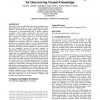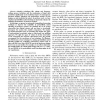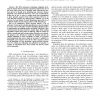1000 search results - page 62 / 200 » Designing for experiences: randomness as a resource |
KDD
2008
ACM
14 years 8 months ago
2008
ACM
Researchers in the social and behavioral sciences routinely rely on quasi-experimental designs to discover knowledge from large databases. Quasi-experimental designs (QEDs) exploi...
QEST
2010
IEEE
13 years 5 months ago
2010
IEEE
Adaptive techniques like voltage and frequency scaling, process variations and the randomness of input data contribute signi cantly to the statistical aspect of contemporary hardwa...
CIBCB
2006
IEEE
13 years 11 months ago
2006
IEEE
Abstract-- The DNA microarray technology, originally developed to measure the level of gene expression, had become one of the most widely used tools in genomic study. Microarrays h...
ASPLOS
2000
ACM
14 years 1 days ago
2000
ACM
By studying the behavior of programs in the SPECint95 suite we observed that six out of eight programs exhibit a new kind of value locality, the frequent value locality, according...
DEBU
2010
13 years 5 months ago
2010
Flash memory affects not only storage options but also query processing. In this paper, we analyze the use of flash memory for database query processing, including algorithms that...



